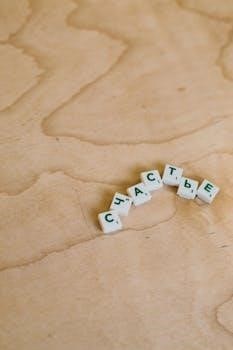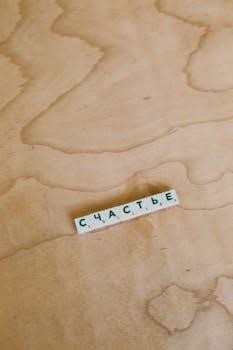
Year 4 Spelling Words PDF⁚ A Comprehensive Guide
Navigating Year 4 spelling can be simplified with a comprehensive PDF guide. These resources typically include statutory word lists‚ common exception words‚ and spelling patterns. A well-structured PDF offers targeted practice and supports effective learning.
Year 4 spelling marks a significant step in a child’s literacy journey. Building upon the foundations laid in previous years‚ the focus shifts towards mastering more complex words and spelling rules. At this stage‚ children are expected to spell accurately and confidently.
The Year 4 curriculum emphasizes the importance of consolidating previously learned graphemes and words‚ particularly those introduced in Years 1 and 2. This review ensures a solid base before progressing to the specific spelling requirements for Years 3 and 4‚ aligning with the national curriculum.
Proficiency in spelling is a key component of writing fluency‚ enabling children to express their ideas clearly and effectively. While reading skills contribute to spelling‚ spelling demands greater precision and motor skills. Introducing effective strategies and engaging activities is essential for successful learning.
Parents and educators play a crucial role in supporting Year 4 spelling development. By providing access to comprehensive resources‚ such as Year 4 spelling words PDF lists‚ worksheets‚ and online tools‚ they can create a stimulating learning environment. Regular practice and revision are vital for reinforcing spelling skills.
Importance of Spelling Proficiency in Year 4
Spelling proficiency in Year 4 is crucial for a child’s overall academic success and confidence. Accurate spelling allows children to communicate their ideas effectively in writing‚ without being hindered by errors. This skill is fundamental for success across various subjects‚ including English‚ history‚ and science.
Good spelling skills contribute significantly to a child’s self-esteem. When children can spell confidently‚ they are more likely to participate actively in class and express themselves creatively in writing. Conversely‚ poor spelling can lead to frustration and reluctance to write.
Furthermore‚ spelling proficiency in Year 4 lays the groundwork for future academic achievements. As children progress through school‚ the complexity of written assignments increases. A strong spelling foundation enables them to tackle these challenges with greater ease and confidence.
Employers also value good spelling skills. In today’s digital age‚ written communication is essential in many professions. Individuals who can spell accurately are more likely to be perceived as competent and detail-oriented. Therefore‚ investing in spelling education in Year 4 has long-term benefits for a child’s future career prospects.
Overview of the Year 4 Spelling Curriculum
The Year 4 spelling curriculum focuses on consolidating previously learned spelling rules while introducing new and more complex patterns. It builds upon the graphemes and words introduced in earlier years‚ reinforcing foundational skills for advanced spelling development. A key element is mastering statutory spellings.
The curriculum emphasizes understanding and applying spelling rules‚ such as adding suffixes and prefixes‚ and recognizing common exception words. These words‚ which don’t follow typical spelling patterns‚ require rote memorization and frequent practice. Exposure to varied texts and contexts is crucial.
Furthermore‚ the Year 4 curriculum often integrates dictation exercises and spelling tests to assess student progress and reinforce learning. Teachers use diverse strategies to cater to different learning styles‚ including visual aids‚ mnemonic devices‚ and interactive games. Home learning support is vital.
The ultimate goal is to equip students with the necessary tools and knowledge to become confident and accurate spellers. By the end of Year 4‚ children are expected to spell a wide range of words correctly and apply spelling rules in their written work‚ preparing them for future academic challenges.

Key Spelling Areas in Year 4
Year 4 spelling focuses on statutory words‚ common exceptions‚ and spelling patterns. Mastering these areas builds a robust foundation. Regular practice and varied activities enhance understanding and retention‚ leading to improved spelling proficiency.
Statutory Spellings for Year 4
Statutory spellings are a crucial component of the Year 4 curriculum‚ representing words children are expected to spell accurately by the end of the academic year. These words are mandated by the national curriculum and form a foundational vocabulary for writing fluency. Mastering these spellings enables children to confidently express themselves in written form.
The statutory spelling list typically includes a mix of common words and words with specific spelling patterns. Regular practice is essential for committing these words to memory. Effective strategies include using flashcards‚ engaging in spelling games‚ and incorporating the words into writing activities. Consistent reinforcement at home and in school is key to success.
Resources like Year 4 spelling lists in PDF format are readily available to support learning. These lists often provide a structured approach to mastering the statutory spellings‚ breaking them down into manageable chunks. By focusing on these essential words‚ children develop a strong spelling foundation that supports their overall literacy development. Regular assessment of these words is also important.
Common Exception Words for Year 4
Common exception words‚ also known as tricky words‚ present a unique challenge in Year 4 spelling. These words deviate from typical spelling patterns‚ making them difficult to decode using phonics alone. They require memorization and repeated exposure to ensure accurate spelling. Many of these words are frequently used‚ making their mastery essential for effective writing.

Strategies for learning common exception words often involve visual aids‚ mnemonics‚ and multi-sensory approaches. Flashcards with memorable images or rhymes can help children associate the word with its correct spelling. Breaking down the word into smaller parts‚ even if those parts don’t follow standard phonetic rules‚ can also be beneficial. Regular practice and review are crucial for retaining these spellings.
Year 4 spelling resources‚ including PDF lists‚ frequently highlight common exception words. These lists serve as a valuable tool for teachers and parents‚ providing a focused approach to tackling these challenging spellings. Consistent reinforcement through games‚ activities‚ and real-world application helps solidify understanding and improve accuracy. Focus on a few words at a time!
Focus on Spelling Patterns and Rules
Year 4 spelling instruction places significant emphasis on understanding and applying spelling patterns and rules. Recognizing common patterns‚ such as adding suffixes like -ing‚ -ed‚ and -er‚ enables students to spell a wider range of words. Learning rules‚ like the “i before e except after c” rule‚ provides a framework for making informed spelling choices.
Teaching spelling patterns involves explicit instruction and ample opportunities for practice. Worksheets‚ games‚ and interactive activities can reinforce these concepts. Students should be encouraged to identify patterns within words and apply rules to new words. Analyzing word families and exploring root words helps build a strong foundation in spelling.
Year 4 spelling lists‚ often available in PDF format‚ can be organized around specific spelling patterns or rules. This allows teachers and parents to target instruction and provide focused practice. By understanding the underlying principles of spelling‚ students develop greater confidence and independence in their writing. Encourage children to break words down into syllables.
Regularly reviewing these patterns and rules throughout the year is essential for long-term retention. Incorporating them into writing activities and providing feedback on spelling errors helps students apply their knowledge in practical contexts.

Resources for Year 4 Spelling
A wealth of resources exists to support Year 4 spelling. These include printable PDF lists‚ engaging worksheets‚ and interactive online platforms. Teachers and parents can leverage these tools to enhance learning and practice.
Free Year 4 Spelling Lists PDF Downloads
Accessing free Year 4 spelling lists in PDF format is a convenient way to support your child’s or students’ learning. These downloadable resources often contain a comprehensive collection of words aligned with the national curriculum‚ including statutory spellings and common exception words. Many websites offer these PDFs for free‚ making them easily accessible to parents‚ teachers‚ and tutors.
These lists can be used for various activities‚ such as weekly spelling tests‚ homework assignments‚ or targeted practice sessions. Look for PDFs that are well-organized‚ clearly formatted‚ and include helpful features like example sentences or word definitions. Some free resources may also offer additional materials‚ such as handwriting practice sheets or spelling rule explanations.
When choosing a PDF‚ consider the specific needs of the learner. Some lists may focus on particular spelling patterns or word families‚ while others provide a more general overview of Year 4 spelling. Remember to supplement these lists with other engaging activities to make learning fun and effective. Always ensure the source is credible to align with educational standards.
Year 4 Spelling Worksheets and Activities
Year 4 spelling worksheets and activities play a crucial role in reinforcing spelling skills and making learning more engaging. These resources provide opportunities for children to practice spelling words in various contexts‚ solidifying their understanding and retention. Worksheets can include activities such as fill-in-the-blanks‚ word searches‚ crossword puzzles‚ and sentence writing exercises. These activities cater to different learning styles‚ ensuring that every child can benefit.
Effective worksheets often focus on specific spelling rules or patterns‚ helping children to identify and apply these rules to new words. Activities that involve manipulating letters‚ such as anagrams or word building games‚ can also be highly beneficial.
To make spelling more fun‚ consider incorporating interactive games and activities into your teaching or home practice. Online spelling games‚ board games‚ and even simple pen-and-paper games can help to motivate children and make learning feel less like a chore. Remember to provide regular feedback and encouragement to help children build confidence and develop a positive attitude towards spelling. Variety is key to keeping children engaged and ensuring that they master the Year 4 spelling curriculum.
Online Spelling Resources for Year 4
Online spelling resources offer a dynamic and interactive way for Year 4 students to enhance their spelling skills. These digital tools provide a range of engaging activities‚ from interactive games and quizzes to virtual spelling bees and personalized learning platforms. Many websites and apps focus specifically on the Year 4 spelling curriculum‚ incorporating statutory word lists‚ common exception words‚ and key spelling patterns.
These resources often provide instant feedback‚ allowing children to identify and correct their mistakes in real-time. Adaptive learning platforms can tailor the difficulty level to each child’s individual needs‚ ensuring they are challenged appropriately. Many online tools also offer progress tracking features‚ allowing parents and teachers to monitor a child’s development and identify areas where they may need extra support.
When selecting online spelling resources‚ it’s essential to choose platforms that are both educational and engaging. Look for websites and apps that offer a variety of activities‚ incorporate multimedia elements‚ and provide opportunities for children to practice spelling in context. Remember to supervise children’s online activity and ensure they are using these resources in a safe and productive manner.

Tips and Strategies for Learning Year 4 Spellings
Effective strategies are key to mastering Year 4 spellings. Focus on understanding spelling rules‚ using mnemonics‚ and practicing regularly. Incorporate multi-sensory techniques and make learning fun to enhance retention and build confidence.
Effective Spelling Strategies for Year 4 Students
Year 4 students can significantly improve their spelling skills by employing a variety of effective strategies. One key approach is to focus on understanding spelling patterns and rules‚ rather than simply memorizing words. Breaking down words into syllables can also make them easier to learn and remember. Encourage the use of mnemonic devices‚ which create memorable associations to aid recall.
Another helpful technique is to incorporate multi-sensory learning. This involves using visual‚ auditory‚ and kinesthetic methods to engage different parts of the brain. For example‚ students can write words in the air‚ use flashcards‚ or listen to audio recordings of the words being pronounced. Regular practice is essential for reinforcing learning. Short‚ frequent practice sessions are more effective than long‚ infrequent ones;
Furthermore‚ encourage students to identify their personal “tricky words” and focus on mastering these. Using spelling games and activities can make the learning process more enjoyable and engaging. Finally‚ provide positive reinforcement and celebrate successes to build confidence and motivation.
Making Spelling Fun and Engaging
Transforming spelling practice into an enjoyable experience is crucial for Year 4 students. Incorporate games like spelling bees‚ crossword puzzles‚ and word searches to make learning interactive. Utilize online spelling platforms and apps that offer engaging activities and rewards. Create a classroom spelling center with hands-on materials such as letter tiles‚ magnetic boards‚ and whiteboards for creative word building.
Encourage students to invent their own spelling games or challenges. Incorporate technology by using interactive whiteboards for group spelling activities. Integrate spelling into other subjects‚ such as having students spell words related to science or history topics. Read aloud books with interesting vocabulary and discuss the spelling of key words.
Turn spelling practice into a collaborative effort by having students work in pairs or small groups. Use colorful markers‚ paper‚ and other art supplies to make spelling visually appealing. Celebrate spelling achievements with small rewards or recognition. By making spelling fun and engaging‚ students will be more motivated to learn and retain new words.